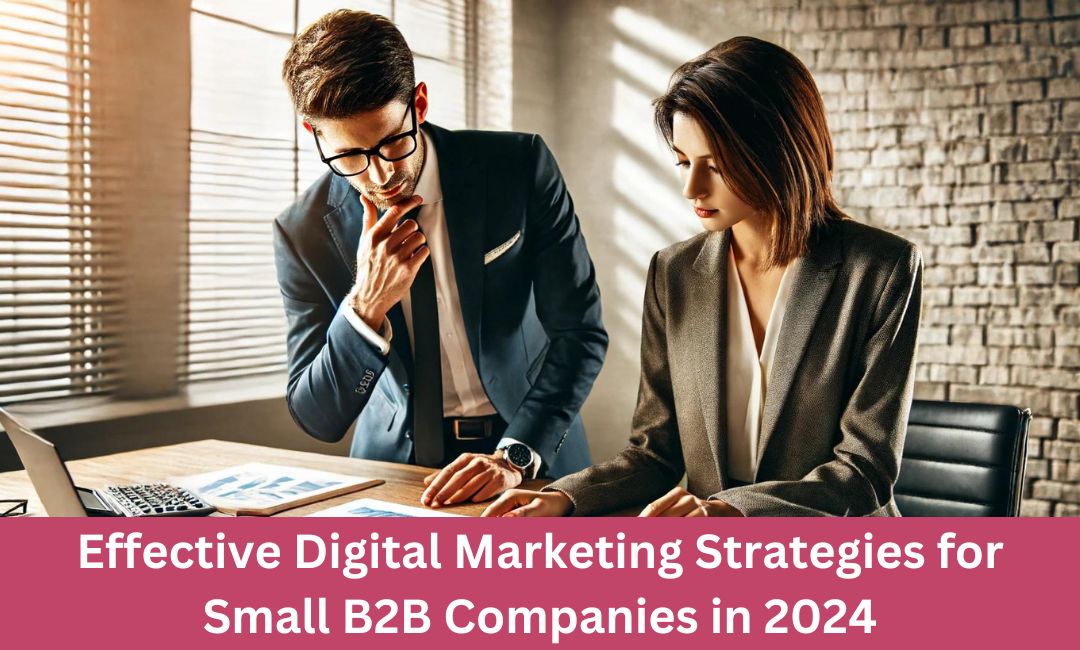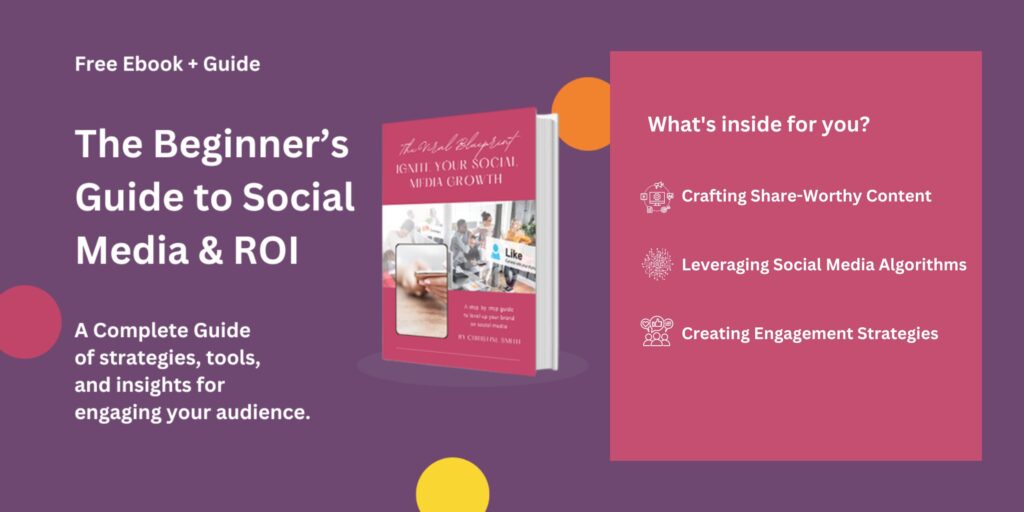In today’s digital age, a solid digital marketing strategy is crucial for small B2B companies to remain ahead of their competitors and effectively reach their target audience. With the ever-evolving Digital Marketing Strategies world, it can be challenging for small B2B companies to keep up with the latest trends and best practices. This article will provide actionable tips and insights on how small B2B companies can effectively implement Digital Marketing Strategies in 2024.
Understanding Your Target Audience
Before planning a digital marketing strategy, it is essential to understand your target audience. This process involves researching and segmenting your audience based on industry, company size, job title, and pain points. By doing so, you can align your digital marketing plan to resonate with your demographic and increase the likelihood of conversion. There are resources you can use such as Google Analytics, social media insights, and customer surveys to research your target audience. These tools can provide valuable data on demographics, interests, and behaviors to help you create buyer personas. Buyer personas are detailed profiles of your ideal customers, including their needs, goals, and challenges. Creating buyer personas ensures your marketing efforts are targeted and relevant to your audience.
For example, a software company must understand its target audience in order to market its services effectively. Here is how they did it:
- Researching the Target Audience:
- Industry : They focused on businesses across various industries, including retail, healthcare, finance, and more.
- Company Size: They targeted small to medium-sized businesses needing mobile app development.
- Job Title: Their primary target was decision-makers such as CEOs, CTOs, and
marketing managers. - Pain Points: They identified that these businesses struggled with creating mobile apps that effectively engaged their customers and provided a seamless user experience.
- Segmenting the Audience:
- Buyer Personas: Based on their research, they created detailed buyer personas. For example, they might have a persona named “CEO Sarah,” a decision-maker
at a small retail business looking to increase customer engagement through a mobile app - Demographics: They analyzed demographics such as age, location, and
company size to define their target audience further - Interests and Behaviors: They used social media insights and Google Analytics to understand the interests and behaviors of their target audience, such as their online activities and preferences.
- Buyer Personas: Based on their research, they created detailed buyer personas. For example, they might have a persona named “CEO Sarah,” a decision-maker
- Tailoring Marketing Efforts:
- Content Marketing: They created content that addressed the pain points of their demographic, such as a blog post on “How to Increase Customer Engagement with Mobile Apps.
- Targeted Advertising: They used digital advertising campaigns on their social
media accounts and Google Ads to reach their target audience - Email Marketing: They created personalized email campaigns that tailored to the needs and goals of their target audience, such as offering free consultations or demos of their mobile app development services.
Content Marketing Strategies
Content marketing is an important part of any digital marketing strategies. It involves creating valuable, relevant, consistent content to attract and retain a clearly defined audience. In 2024, small B2B companies can leverage AI for data-driven content creation. AI-powered tools can help analyze data and generate optimized content for search engines that resonates with your target audience.
In addition to AI-generated content, small B2B companies can engage their audience through video marketing and interactive content. Video content, such as educational videos and product demos, can help explain complex products and services in an easy-to-understand format. Interactive content like quizzes and assessments can help personalize the user experience and increase engagement.
A small B2B company specializing in cybersecurity solutions wanted to create a content marketing strategy to attract and retain its target audience. Here is how they did it:
- AI-Generated Content:
- Data Analysis: They used AI-powered tools to analyze data on their target
audience, including demographics, interests, and behaviors. - Content Generation: The AI tools generated content optimized for search engines and resonated with their target audience. This marketing strategy included blog posts, social media posts, and email newsletters.
- Data Analysis: They used AI-powered tools to analyze data on their target
- Video Marketing:
- Explainer Videos: They created explainer videos that explained complex
cybersecurity concepts in an easy-to-understand format. They shared these
videos on their website, social media, and YouTube at a small retail business looking to increase customer engagement through a mobile app - Product Demos: They created product demos showcasing the features and
benefits of their cybersecurity solutions, which they shared on their website and social media.
- Explainer Videos: They created explainer videos that explained complex
- Interactive Content:
- Quizzes: They created quizzes that helped users assess their cybersecurity risks
and provided personalized recommendations for improvement. - Assessments: They created assessments that helped users evaluate their
cybersecurity posture and provided tailored solutions to address vulnerabilities
- Quizzes: They created quizzes that helped users assess their cybersecurity risks
Email marketing is another effective digital marketing strategies for small B2B companies. To build and nurture email lists, small B2B companies can offer free resources, host webinars, and create gated content. Once you email list is built, you can personalize email campaigns based on industry, company size, and job title.
Personalization is critical to successful email marketing. Using data and analytics, you can write your email content so your audience can identify and increase the likelihood of conversion. Additionally, it is essential to emphasize relevance and engagement in email content. This happens using attention-grabbing subject lines, concise and clearcontent, and clear calls to action.

A law firm focusing on intellectual property law wanted to create an email marketing strategy to attract and engage its target audience. Here is how they did it:
- Building the Email List:
- Free Resources: They created a free guide to intellectual property law and
offered it on their website in exchange for email addresses. - Webinars: They hosted webinars on “Protecting Your Intellectual Property in the Digital Age” and required attendees to register with their email addresses.
- Gated Content: They created a series of blog posts on intellectual property law and required readers to provide their email addresses to access the full content.
- Free Resources: They created a free guide to intellectual property law and
- Personalizing Email Campaigns::
- Industry: They segmented their email list by industry, such as technology,
healthcare, and finance, and tailored their email content to the specific needs and challenges of each sector at a small retail business looking to increase customer engagement through a mobile app. - Company Size: They segmented their email list by company size, such as small startups and large corporations, and tailored their content to address each company’s specific needs and challenges.
- Job Title: They segmented their email list by job titles, such as CEOs, CTOs, and legal counsel, and tailored their content to address the specific needs and challenges of each job title.
- Industry: They segmented their email list by industry, such as technology,
- Personalization and Engagement:
- Attention-Grabbing Subject Lines: They used subject lines such as “Protect Your Intellectual Property from Cyber Threats” and “Don’t Let Your Competitors Steal Your Ideas.
- Concise and Clear Content: They kept their email content concise and clear,
focusing on the key points and takeaways their audience needed to know. - Clear Calls to Action: To encourage engagement and conversion, they included clear calls to action in their emails, such as “Schedule a Consultation” or “Download Our Free Guide.”
Digital Advertising Strategies
Digital advertising is an excellent way to reach your target audience and drive conversions. In 2024, small B2B companies can use AI-generated video content for personalized product recommendations. AI-powered tools can help analyze data and generate video content optimized for search engines that resonate with your target audience.
In addition to AI-generated video content, small B2B companies can also implement targeted digital advertising campaigns. This marketing strategy uses data and analytics to target specific demographics, interests, and behaviors. By targeting the right audience, you can increase the likelihood of conversion and maximize your efforts.
- AI-Generated Video Content:
- Data Analysis: They used AI-powered tools to analyze data on their target
audience, including demographics, interests, and behaviors. - Video Generation: The AI tools generated video content optimized for search
engines and resonated with their target audience. The videos included product demos, tutorials, and testimonials.
- Data Analysis: They used AI-powered tools to analyze data on their target
- Targeted Digital Advertising Campaigns:
- Demographics: They targeted demographics such as age, location, and job title to reach their target audience.
- Interests: They targeted specific interests such as automotive repair, aftermarket parts, and vehicle maintenance.
- Behaviors: They targeted specific behaviors such as online searches for
aftermarket parts, purchases of similar products, and engagement with
automotive content.
- Personalized Product Recommendations:
- AI-Powered Recommendations: They used AI-powered tools to analyze customer data and generate personalized product recommendations based on purchase history, search queries, and browsing behavior.
- Dynamic Ad Content: They used dynamic ad content to display personalized product recommendations in their digital ads, increasing the likelihood of conversion.
Search Engine Optimization (SEO)
SEO is an essential element of a digital marketing plan. It entails optimizing your website content to rank higher in search engine results pages (SERPs). Optimizing your website content for search engines, increases brand visibility, drives organic traffic, and generates leads.
You can use various tactics such as keyword research, on-page optimization, and link building to optimize your website content for search engines. Keyword research involves identifying relevant keywords and phrases your target audience is searching for. On-page optimization involves optimizing your website content, meta tags, and header tags for search engines. Link building involves building high-quality backlinks from authoritative sources to increase your website’s authority and ranking.
- Keyword Research:
- Identifying Relevant Keywords: They identified relevant keywords and phrases that their demographic was searching for, such as “American flags,” “custom flags,” and “flag poles.”
- Keyword Analysis: They analyzed each keyword’s competition, search volume, and relevance to determine the most effective keywords to target.
- On-Page Optimization:
- Optimizing Website Content: They optimized their website content to include the target keywords, ensuring it was high-quality, informative, and engaging.
- Meta Tags and Header Tags: They optimized their meta tags and header tags to include the target keywords, improving the website’s visibility in search engine results pages (SERPs).
- Link Building:
- Building High-Quality Backlinks: They built high-quality backlinks from reliable sources such as government websites, educational institutions, and other reputable websites
- Guest Blogging: They wrote guest posts for other reputable websites in the industry, including a link to their website.
Example of Optimized Website Content:
Page Title: American Flags | Custom Flags | Flag Poles | [Flag E-commerce Store]
Meta Description: Find high-quality American flags, custom flags, and flag poles at [Flag Ecommerce Store]. Browseour selection of flags and get fast shipping.
Header Tags:
- H1: American Flags and Custom Flags
- H2: Flag Poles and Accessories
- Introduction: At [Flag E-commerce Store], we understand the importance of having the right flag for your needs. That’s why we offer a wide selection of high-quality American flags, custom flags, and flag poles.
- Product Description: Our American flags are made from durable materials and are available in various sizes. Our custom flags are designed to meet your needs and are made from high-quality materials. Our flag poles are sturdy and easy to install.
Social Media Marketing Strategies
Social media marketing is another useful digital marketing strategy for small B2B companies. It involves leveraging social media platforms to reach your demographic, increase brand awareness, and drive leads. To design engaging content for social media platforms, you can use various tactics such as creating visually appealing graphics, humor, storytelling and asking questions and polls.
In addition to creating engaging content, small B2B companies can use social media reporting to measure performance and optimize campaigns. Social media reporting tools can provide valuable insights into engagement, click-through, and conversion rates. Studying these metrics allows you to refine your social media strategy and maximize your ROI.
- Creating Engaging Content:
- Visually Appealing Graphics: They created visually appealing graphics highlighting the benefits of their tutoring services, such as improved grades and increased confidence.
- Humor and Storytelling: They used humor and storytelling to make their content more relatable and engaging, such as sharing their students’ success stories.
- Questions and Polls: They asked questions and polls to encourage engagement and start conversations with their audience, such as “What’s the most challenging subject for you?” or “Do you prefer online or in-person tutoring?”
- Social Media Analytics:
- Engagement Rates: They tracked engagement rates to see which types of content resonated with their audience and adjusted their strategy accordingly.
- Click-Through Rates: They tracked click-through rates to see which content drove the most traffic to their website and optimized their ads for better
performance. - Conversion Rates: They tracked conversion rates to see which content led to the most leads and sales and refined their strategy to maximize ROI.
Example of Engaging Content:
Facebook Post:
Struggling with math? 🤯 We’ve got you covered. Our professional tutors can help you improve your grades and build confidence. Share with a friend who needs help 🤝 #mathhelp #tutoring
Instagram Post:
Who else is tired of feeling stuck in their studies? Our tutoring services can help you break through the barriers and achieve your goals. Swipe up in our stories to learn more 📚#tutoring #studytips
Twitter Post:
Need help with your science homework? 🧬 Our tutors are here to assist you. DM us to schedule a session 📲 #sciencehelp #tutoring
By using social media marketing, the tutoring company reached its target audience, increased brand awareness, and drove leads. By analyzing engagement, click-through, and conversion rates, the company refined its strategy and maximized its ROI.

Implementing and Measuring Success
Small B2B companies must set clear goals and objectives to implement a successful digital marketing strategy. This process involves identifying key performance indicators (KPIs) that measure campaign success. Key Performance Indicators include website traffic, lead generation, conversion rates, and ROI.
Once you have set clear goals and objectives, you can track KPIs to measure campaign success. You can maximize your ROI and achieve your business goals by continuously refining and optimizing your digital marketing strategy based on data insights.
A small B2B company specializing in software solutions wanted to implement a successful digital marketing strategy to increase brand awareness, generate leads, and drive sales. Here is how they did it:
- Setting Clear Goals and Objectives:
- Increase Website Traffic: They wanted to increase website traffic by 20% within the next six months.
- Generate Leads: They wanted to generate 50 new leads per month through their website.
- Conversion Rates: They wanted to increase conversion rates by 15% within the next three months.
- ROI: They wanted to achieve an ROI of 300% on their digital marketing spend.
- Identifying KPIs:
- Website Traffic: They tracked website traffic using Google Analytics.
- Lead Generation: They tracked lead generation using marketing automation software.
- Conversion Rates: They tracked conversion rates to see which content led to the most leads and sales and refined their strategy to maximize ROI.
- ROI: They tracked ROI using financial reports.
- Tracking KPIs:
- Monthly Reporting: They tracked KPIs every month to measure campaign success.
- Data Analysis: They analyzed data to identify trends, opportunities, and challenges.
- Refining Strategy: They refined their digital marketing strategy based on data findings to maximize ROI and achieve business goals.
Conclusion
In conclusion, implementing a successful digital marketing strategy in 2024 requires a thorough understanding of your demographic, effective content marketing strategies, personalized email marketing campaigns, targeted digital advertising, SEO, social media marketing, and continuous measurement and optimization. By following these actionable tips and insights, small B2B companies can stay competitive and reach their target audience effectively in the rapidly evolving digital marketing landscape.
For personalized digital marketing solutions tailored to your B2B needs, reach out to Smurk Media today. Let us help you stay ahead in the ever-evolving digital landscape of 2024. Contact us now and let’s build your success together.


